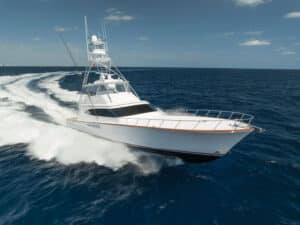When Shepard “Shep” McKenney teamed up with naval architect John Adams to form Seakeeper, he probably didn’t realize he would forever change the way people thought about boats.
The Marlin team had a chance to spend the afternoon with McKenney during his recent visit to the Seakeeper manufacturing facility in Mohnton, Pennsylvania, from the company’s corporate offices in California, Maryland. An attorney-turned-entrepreneur, McKenney had previously been at the helm of a large hotel chain, and also Hinckley Yachts, where he had a hand in designing their world-famous line of picnic boats. Hinckley’s shallow draft and fly-by-wire joystick controls were revolutionary, and it led McKenney down the path toward developing a way to use gyrostabilization to dampen a boat’s rolling motion.
Enter John Adams, one of the world’s foremost experts in the field of gyrostabilization. He founded and then sold a company called Maritime Dynamics that pioneered motion control in high-speed ferries and military vessels. Rather than using fins or appendages on the hull, Adams developed a way to counter the torque of a boat’s roll using a gyro spinning at very high speed.
“I see myself as a problem-solver,” he says. “We hire very talented employees, so I spend a lot of time helping them overcome any obstacles in being successful. I enjoy talking with the engineers and working on our new products as well.”
One of those exciting new products is the Seakeeper 3, a unit that’s designed for boats as small as 30 feet in length. The unit mounts within a leaning post on deck and requires the addition of just one extra battery and one thru-hull feed for raw-water cooling. Since the company’s introduction, Seakeeper has about 3,500 gyrostabilizers in the field, and will ship about 1,200 gyros in 2017.







